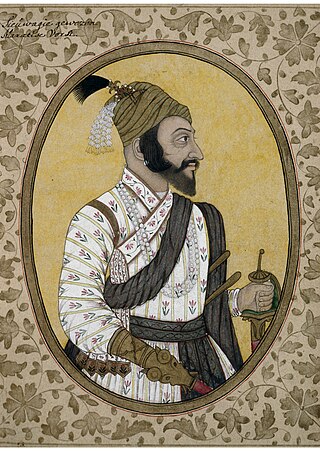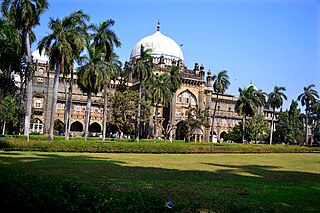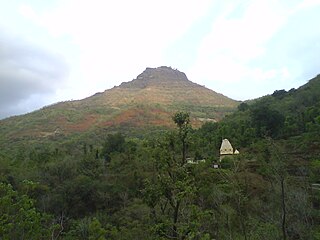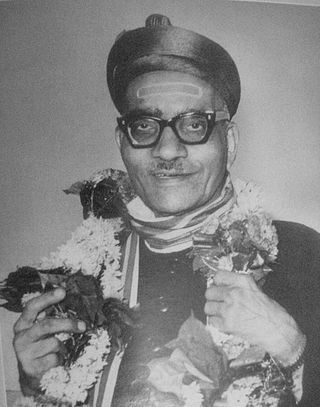
Shivaji I was an Indian ruler and a member of the Bhonsle Maratha clan. Shivaji carved out his own independent kingdom from the declining Adilshahi Sultanate of Bijapur that formed the genesis of the Maratha Empire. In 1674, he was formally crowned the Chhatrapati of his realm at Raigad Fort.

Chhatrapati Shivaji Maharaj Vastu Sangrahalaya, (CSMVS) originally named Prince of Wales Museum of Western India, is a museum in Mumbai (Bombay) which documents the history of India from prehistoric to modern times.

Peshwa was second highest office in the Maratha Confederacy, next in rank and prestige only to that of the Chhatrapati. Initially serving as the appointed prime minister in the Maratha empire, the office became hereditary after the death of Shahu in 1749. During the reign of Shahu, the office of Peshwa grew in power and the Peshwas came to be the de facto rulers of the Maratha empire. However following the defeat of the Marathas in 1761, the office of the Peshwa became titular as well and from that point onwards served as the ceremonial head of the Confederacy underneath the Chhatrapati.

Jijabai Bhonsle (or Bhonsale, Bhosale, Bhosle) or Jadhav, referred to as Rajmata, Rastramata, Jijabai, Jijamata or Jijau, was the mother of Chattrapati Shivaji, founder of the Maratha Empire. She was a daughter of Lakhujirao Jadhav of Sindkhed Raja.

Pune district is a district in Western Maharashtra with Administrative Headquarters in Pune city. Pune district is the most populous district in the Indian state of Maharashtra. It is one of the most industrialised districts in India.
Ashta Pradhan was a system of ministerial delegation in the Maratha empire. The council is credited with having implemented good governance practices in the Maratha heartland, as well as for the success of the military campaigns against the Mughal Empire.

Chiplun ( [t͡ʃipɭuːɳ]) is a city in Ratnagiri district in the state of Maharashtra, India. It is one of the financial and commercial Hubs of Ratnagiri district, and the headquarters of Chiplun taluka. It is about 250 km south of Mumbai and 90 km North of Ratnagiri in the Konkan region of Maharashtra, on the Mumbai–Goa highway (NH-66). It has a long history and a strong cultural background. Recent decades have seen much industrial development in it and its and surrounding areas.
Indapur is a town and a municipal council in Pune district in the Indian state of Maharashtra. Indapur is known for Jahagir of Chhatrapati Shivaji Maharaj's father and grandfather. Chhatrapati Shivaji Maharaj's grandfather Malojiraje died in battle in Indapur.

Mangalgad, also known as Kangori, is a fort in Maharashtra near the village of Dudhanewadi. Kangori, or Mangalgad Fort, is in the Mahad sub-division about eleven miles (18 km) east by south from Mahad town.

The Battle of Sinhagad, also known as Battle of Kondhana, involved an attack by the forces of the Maratha Empire during the night of 4 February 1670 on the fort of Sinhagad, near the city of Pune, Maharashtra. The Marathas captured the fort.

Shri Shahu Chhatrapati Maharaj of Kolhapur is the descendent of Chhatrapati Shivaji Maharaj and the great-grandson of Rajarshi Chhatrapati Shahu Maharaj of Kolhapur and the son and heir of Maj. Gen. Shahaji Chhatrapati Maharaj of Kolhapur. He studied at the Bishop Cotton School, Bangalore and later on graduated from the Indore Christian College in 1967 with History, Economics and English literature.

Dattatray Vaman Potdar, better known as Datto Vaman Potdar, was an Indian historian, writer, and orator. He was the Vice-Chancellor of University of Pune during 1961 - 1964.

Balwant Moreshwar Purandare, popularly known as Babasaheb Purandare, was an Indian writer of books and plays from Maharashtra, India. His works are mostly based on the life of Chatrapati Shivaji Maharaj, the 17th-century founder of the Maratha Empire; as a result he is called Shiv-Shahir. He is mostly known for his popular play on Shivaji, Jaanta Raja. Purandare also studied the history of the Peshwas of Pune. In 2015, he was awarded the Maharashtra Bhushan Award, Maharashtra's highest civilian award. He was awarded the Padma Vibhushan, India's highest second-civilian award on 25 January 2019.
Pune is the 9th most populous city in India and one of the largest in the state of Maharashtra.

Vijaydurg, the oldest fort on the Sindhudurg coast, was constructed during the regime of Raja Bhoja II of the Shilahar dynasty and restructured by Chhatrapati Shivaji Maharaj.
Chintaman Vinayak Vaidya was a Marathi-language historian and writer from Bombay Presidency, British India. He was Chief Justice of Gwalior State for a period. He was born in a Chitpavan Brahmin family.

The following list includes a brief about the titles of nobility or orders of chivalry used by the Marathas of India and by the Marathis/Konkanis in general.

Vele is a village in the Western region of Maharashtra state in India. It is located in Satara district of Maharashtra. Before it was a part of Bombay State and Princely state of Satara. It is located adjacent to Kanher Dam built on Venna River. There is a big temple of Bhairava at the village entrance. Also there are number of temples in closed vicinity of village. Surrounded by greenery and farms, agriculture is the main occupation in the village with more than 80% of the total area being used for agricultural activities. Though agriculture constitutes a mainstay of the economy of this village, besides a sizeable population working at various plum government positions does bolster the financial position.

Chandrashekhar Govind Agashe was an Indian industrialist and lawyer, best remembered as the founder of the Brihan Maharashtra Sugar Syndicate Ltd. He served as the managing agent of the company from its inception in 1934 till his death in 1956. He served as the President of the Bhor State Council from 1934 to 1948, having previously been the council's Vice President from 1933 to 1934, its Secretary from 1932 to 1933, and the Chief Justiciar of the Indian princely state itself from 1920 to 1932.

Vasudeo Sitaram Bendrey was historian, author, editor, translator and publisher in Marathi language. He is known as Bhishmacharya of Marathi History. He dedicated his work for research in Maharashtra history and wrote, edited and translated over 60 books on different history topics.



















